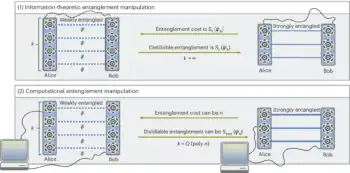
Physicists in China claim to have teleported the quantum states of photons nearly 100 km in free space, breaking the previous record by a factor of 100. The development could pave the way for satellite-based quantum communication, or fundamental tests of quantum mechanics over long distances.
Quantum teleportation is a way of transferring a quantum state from one place to another without actually sending a particle in that state through space. In the normal arrangement, two people, Alice and Bob, each take one half of a pair of entangled particles and then go their separate ways. Whenever Alice wants to send a quantum state to Bob, she allows a third particle in that state to interact with her half of the entangled pair of particles.
Alice then sends the result of a measurement on the system to Bob using a conventional (non-quantum) means of communication. Bob uses this information to modify his half of the entangled pair such that it is in a quantum state identical to the state that Alice wanted to send. This occurs despite the fact that Alice never actually sent a particle in that state. Another bizarre outcome of the process is that although the original copy of Alice’s state is destroyed by her measurement, Bob can be made to reappear nearly 100 km away.
This process was first proposed in 1993 by IBM’s Charles Bennett and works because of the strange property of entanglement. This allows two or more particles, having interacted, to remain linked in a manner not possible in classical physics – no matter what the distance separating them. Since Bennett’s proposal, quantum teleportation has been performed over short distances in the lab using photons and atoms, and over kilometre distances using fibre-optic cables. In 2010 physicist Jian-Wei Pan of the University of Science and Technology of China in Shanghai and colleagues went one better by teleporting photons over 16 km without any fibre optics – that is, over free space.
Inside, not outside
Pan says that demonstration had limited practical use, because the teleported photon had to be prepared “inside” the experiment. This is contrary to the operation of actual quantum networks, which process quantum bits of information, or qubits, that are unknown and come from outside. “In most of the quantum-communication schemes and in distributed quantum computation, the initial state is really unknown and from an independent qubit,” says Pan.
Now, Pan’s team claims to have repeated the experiment with photon qubits created outside, and extended the teleportation distance to 97 km – all the way across Qinghai Lake in western China. The experiment begins with an intermediary, “Charlie”, preparing an entangled pair of photons by sending an ultraviolet laser beam through a barium crystal. Charlie sends one half of these entangled photons to a group of “Alice” researchers nearby, and the other half to a group of “Bob” researchers on the other side of the lake, via a telescope. Using an ultraviolet laser, the Alice group then creates new photons that it wants to teleport and lets them interact with the original, entangled photons by performing a so-called Bell measurement.
In the final step, the Alice group transmits the outcome of its Bell measurements to the Bob group via a conventional wireless link. Pan’s team found that the Bob group could recreate the new photons from Alice’s group with a fidelity of 80% – that is, the teleported photons on average retained 80% of their characteristics compared with how they were before they were teleported.
Satellite communications
Pan believes the results constitute a new record. “Compared with previous quantum teleportation with [multiple] photons, our teleportation has increased the distance by two orders of magnitude,” he says. “Our result shows the feasibility of performing quantum teleportation between satellites and ground stations. Achieving quantum communication and performing fundamental tests of the laws of quantum mechanics on a global scale is definitely the next goal.”
Physicist Nicolas Gisin of the University of Geneva in Switzerland, who is co-founder of a company called ID Quantique that manufactures quantum-cryptography systems, lauds the work, but believes it “cheats a bit”. One potential cheat, he says, is that the same ultraviolet laser appears to be generating both the entangled photons and the photons to be teleported, which would not happen in a practical system. Another concerns when the teleportation actually occurs. “When the Bell-state measurement – which triggers the teleportation process – is performed by Alice, the photon travelling towards Bob [has] barely left,” Gisin says. “At best it is a few metres away. Hence, the claimed teleportation over 97 km is a bit excessive.”
Still, Gisin thinks the demonstration is “impressive”. “This paper is welcome and will attract attention,” he adds.
The results have been published on the arXiv preprint server.



